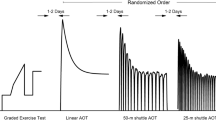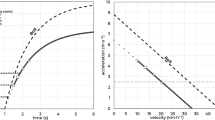Abstract
Purposes
The energy cost of shuttle running (C netSR), over distances of 10–20 m, was reported to increase with the shuttle speed and to decrease with the shuttle distance. The aims of this study were to assess C netSR over a shorter distance (5 m), at different speeds, and to estimate the energy cost based on a simple kinematic analysis (C netK).
Methods
Ten subjects (six basketball players, BP; four non-basketball players, NBP) performed ten shuttle runs (SR) with 30 s of passive recovery in-between, over a distance of 5 + 5 m (with a 180° change of direction); these experiments were repeated at different speeds (range 2–3.5 m s−1). The values of average (v mean) and maximal (v max) speed during each run were determined by means of kinematic analysis and C netK was calculated as: 0.96\(v_{ \hbox{max} }^{ 2}\). C netSR was calculated based on data of oxygen uptake, blood lactate concentration and distance covered.
Results
The relationships between C (J m−1 kg−1) and v (m.s−1) are well described by C netK (all subjects) = 11.76v − 13.09, R 2 = 0.853; C netSR (BP) = 11.94v − 12.82, R 2 = 0.636; and C netSR (NBP) = 14.09v − 14.53, R 2 = 0.738. Hence C netSR ≈ C netK in BP, whereas C netSR > C netK in NBP (un-familiar with this specific motor task).
Discussion
The calculations proposed in this study allow to estimate C of short SR based on simple measures of v max and can be utilized to develop training protocols in basketball as well as in other team sports (characterized by repeated sprints over short distances).




Similar content being viewed by others
Abbreviations
- BCoM:
-
Body centre of mass
- BP:
-
Basketball players
- C netLR :
-
Net energy cost of linear running (metabolic data)
- C netSR :
-
Net energy cost of shuttle running (metabolic data)
- C extbout :
-
The minimum energy cost of a SR (derived from kinematic analysis)
- C netK :
-
Net energy cost of shuttle running (kinematic data): 2C extbout
- d :
-
Shuttle distance
- E’O2bout :
-
Net energy expenditure during a shuttle run
- E K :
-
Kinetic energy
- E P :
-
Potential energy
- \(E_{\text{ext}}^{ + }\) :
-
Energy associated with positive external work
- \(E_{\text{ext}}^{ - }\) :
-
Energy associated with negative external work
- E extbout :
-
Energy expenditure during a shuttle run (derived from kinematic analysis)
- HR:
-
Heart rate
- Lab :
-
Blood lactate concentration
- NBP:
-
Non-basketball players
- RER:
-
Respiratory exchange ratio
- SI:
-
Index of symmetry
- SR:
-
Shuttle run
- t bout :
-
Duration of one run/bout
- t ex :
-
Exercise duration (=10t bout)
- t tot :
-
Total exercise duration (=t ex plus the recovery periods)
- t tot/t ex :
-
An index of the work to rest ratio
- t vmax :
-
Time needed to attain v max
- v mean :
-
Average (horizontal) shuttle speed
- v max :
-
Maximal (horizontal) shuttle speed
- V′O2 :
-
Oxygen uptake
- V′E:
-
Minute ventilation
- \(W_{\text{ext}}^{ + }\) :
-
Positive external work
- \(W_{\text{ext}}^{ - }\) :
-
Negative external work
- W extbout :
-
External work during a shuttle run
- η + :
-
Positive work efficiency
- η − :
-
Negative work efficiency
References
Abbot BC, Bigland B, Ritchie JM (1952) The physiological cost of negative work. J Physiol 117:380–390
Ahn AN, Furrow E, Biewener AA (2004) Walking and running in the red-legged running frog, Kassina maculata. J Exp Biol 207:399–410
Ben Abdelkrim N, El Fazaa S, El Ati J (2007) Time-motion analysis and physiological data of elite under-19-year-old basketball players during competition. Br J Sports Med 41:69–75
Ben Abdelkrim N, Castagna C, Jabri I, Battikh T, El Fazaa S, El Ati J (2010) Activity profile and physiological requirements of junior basketball players in relation to aerobic-anaerobic fitness. J Strength Cond Res 24:2330–2342
Biewener AA (2006) Patterns of mechanical energy change in tetrapod gait: pendula, springs and work. J Exp Zoo 305:899–911
Bland JM, Altman DG (1986) Statistical methods for assessing agreement between two methods of clinical measurement. Lancet 1:307–310
Buglione A, di Prampero PE (2013) The energy cost of shuttle running. Eur J Appl Physiol 113:1535–1543
Cavagna GA, Kaneko M (1977) Mechanical work and efficiency in level walking and running. J Physiol 268:467–481
di Prampero PE, Ferretti G (1999) The energetics of anaerobic muscle metabolism: a reappraisal of older and recent concepts. Resp Physiol 188:103–115
di Prampero PE, Fusi S, Sepulcri L, Morin JB, Belli A, Antonutto G (2005) Sprint running, a new energetic approach. J Exp Biol 208:2809–2816
Heglund NC, Cavagna GA (1985) Efficiency of vertebrate locomotory muscles. J Exp Biol 115:283–292
Hoffman JR, Maresh CM (2000) Physiology of basketball. In: Garret WE, Kirkendall DT (eds) Exercise and sport science. Lippincott Williams & Williams, Philadelphia, pp 733–744
Margaria R (1938) Sulla fisiologia e specialmente sul consumo energetico della marcia e della corsa a varia velocità ed inclinazione del terreno. Att. Acc. Naz. Lincei 7:299–368
Margaria R, Oliva RD, di Prampero PE, Cerretelli P (1969) Energy utilization in intermittent exercise at supramaximal speeds. J Appl Physiol 26:752–756
McInnes SE, Carlson JS, Jones CJ, Mckenna MJ (1995) The physiological load imposed on basketball players during competition. J Sports Sci 13:387–397
Minetti AE, Moia C, Roi GS, Susta D, Ferretti G (2002) Energy cost of walking and running at extreme uphill and downhill slopes. J Appl Physiol 93:1039–1046
Osgnach C, Poser S, Bernardini R, Rinaldo R, di Prampero PE (2010) Energy cost and metabolic power in elite soccer: a new match analysis approach. Med Sci Sports Exerc 42:170–178
Rubenson J, Heliams DB, Lloyd DG, Fournier PA (2004) Gait selection in the ostrich: mechanical and metabolic characteristics of walking and running with and without an aerial phase. Proc Biol Sci 271:1091–1099
Saibene F, Minetti AE (2003) Biomechanical and physiological aspects of legged locomotion in humans. Eur J Appl Physiol 88:297–316
Scanlan A, Dascombe B, Reaburs P (2011) A comparison of the activity demands of elite and sub-elite Australian men’s basketball competition. J Sport Sci 29:1153–1160
Schot P, Dart J, Schuh M (1995) Biomechanical analysis of two change-of-direction maneuvers while running. J Orthop Sports Phys Ther 22:254–258
Stevens TGA, de Ruiter CJ, van Maurik D, van Lierop CJW, Savelsbergh GJP, Beek PJ (2014) Measured and estimated energy cost of constant and shuttle running in soccer players. Med Sci Sports Exerc. Publication ahead of print
Willems PA, Cavagna GA, Heglund NC (1995) External, internal and total work in human locomotion. J Exp Biol 198:379–393
Zadro I, Sepulcri L, Lazzer S, Fregolent R, Zamparo P (2011) A protocol of intermittent exercise (shuttle runs) to train young basketball players. J Strength Cond Res 25:1767–1773
Zamparo P, Zadro I, Lazzer S, Beato M, Sepulcri L (2014) Energetics of shuttle runs: the effects of distance and change of direction. Int J Sport Physiol Perf 9:1033–1039
Acknowledgments
We wish to thank prof. A. E. Minetti for his helpful remarks and useful comments.
Author information
Authors and Affiliations
Corresponding author
Additional information
Communicated by Peter Krustrup.
Rights and permissions
About this article
Cite this article
Zamparo, P., Bolomini, F., Nardello, F. et al. Energetics (and kinematics) of short shuttle runs. Eur J Appl Physiol 115, 1985–1994 (2015). https://doi.org/10.1007/s00421-015-3180-2
Received:
Accepted:
Published:
Issue Date:
DOI: https://doi.org/10.1007/s00421-015-3180-2




